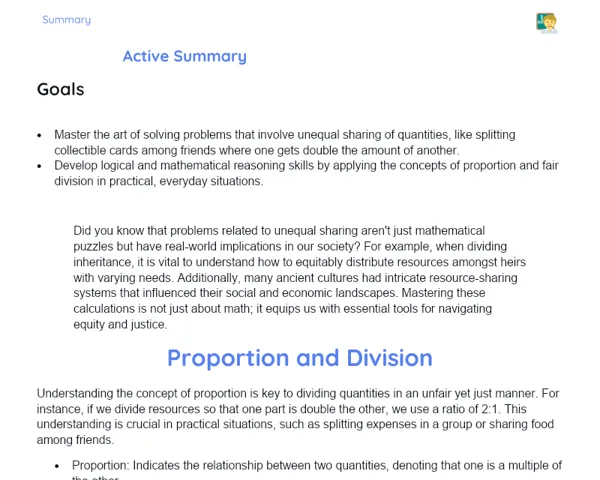Summary Tradisional | System of Equations
Contextualization
To start grasping the concept of systems of equations, it's vital to acknowledge that many scenarios in our daily lives require us to solve problems involving two or more linked variables. For instance, think about planning a celebration where you need to purchase drinks and snacks. If you're aware of their prices and the total budget you've allocated, how do you figure out how much of each item to buy? Such problems can be tackled using systems of equations, which comprise a collection of two or more equations that incorporate the same variables.
Systems of equations play a significant role across different sectors, be it economics, engineering, or even in video games. For instance, in economics, they are essential for modeling market trends and forecasting consumer behaviour. In the realm of gaming, they help program interactions among diverse characters and game components. Therefore, mastering how to solve systems of equations becomes an invaluable skill for both academic pursuits and practical applications in real-life scenarios.
To Remember!
Definition of a System of Equations
A system of equations refers to a collection of two or more equations that share common variables. The aim of solving such a system is to pinpoint values for these variables that satisfy all equations at once. In simpler terms, we’re on the lookout for a set of values making every equation true simultaneously.
Various types of systems exist, such as linear and nonlinear ones. In this lesson, we will specifically delve into linear systems, characterised by first-degree equations. A basic illustration of a linear system is the equations {x + y = 6, 2x - y = 3}. To solve this, we must identify values for x and y that meet both equations’ criteria.
Acquiring the skill to solve systems of equations is crucial in mathematics, as it prepares us to tackle issues involving multiple interdependent variables. Moreover, understanding these systems is key to applying mathematical principles across diverse areas of study, including physics, economics, and engineering.
-
A system of equations includes two or more equations sharing the same variables.
-
The goal is to uncover values that satisfy all equations at the same time.
-
We concentrate on linear systems, made up of first-degree equations.
Substitution Method
The substitution method is a strategy for solving systems of linear equations. It entails isolating one of the variables in one equation and then substituting that expression into the other equation. This simplifies the original system to one equation involving a single variable, which can then be solved straightforwardly.
For example, let’s take the system {x + y = 6, 2x - y = 3}. Initially, we solve the first equation for one variable, let’s say y: y = 6 - x. Next, this expression is substituted into the second equation: 2x - (6 - x) = 3. Simplifying leads us to 3x - 6 = 3. Solving for x gives us x = 3. Finally, placing x = 3 back into our expression for y gives us y = 3.
This technique shines when one of the equations proves easy to solve for a particular variable. However, it may be less effective when dealing with more complicated equations or those that don’t lend themselves easily to substitution.
-
It involves resolving one equation for a variable and substituting it into another equation.
-
This reduces the system to a single equation with just one variable.
-
Particularly useful when one of the equations can easily be solved for a variable.
Addition/Elimination Method
The addition or elimination method is another technique utilized for solving systems of linear equations. This method requires adding or subtracting equations within the system to eliminate one of the variables. This produces a new equation featuring only one variable, which can be solved directly.
Take for example the system {3x + 2y = 16, 2x - 2y = 4}. Initially, we can add the two equations to eliminate y: (3x + 2y) + (2x - 2y) = 16 + 4, simplifying to 5x = 20. From this, solving for x gives us x = 4. We then substitute x = 4 back into one of the original equations, say the first: 3(4) + 2y = 16. This simplifies to 12 + 2y = 16, leading us to 2y = 4, thus y = 2.
This method is particularly efficient for systems that can be easily manipulated to eliminate one of the variables through addition or subtraction, and it proves to be a robust technique when dealing with larger or more intricate systems.
-
This involves either adding or subtracting equations to eliminate a variable.
-
This results in a fresh equation with a single variable.
-
Highly effective for systems that are easy to manipulate.
Types of Solutions for Systems of Equations
Systems of equations can yield various types of solutions, based on the relationship shared between the equations. Typically, there are three main solution types: a unique solution, infinitely many solutions, and no solution.
A system is said to have a unique solution when the equations intersect at a single point on the Cartesian plane. This happens when the equations are both independent and consistent. For instance, the system {x + y = 6, 2x - y = 3} presents a unique solution at the point (3, 3).
Conversely, a system boasts infinitely many solutions when the equations represent the same line — meaning they are multiples of one another. This situation arises when the equations are dependent yet consistent. An example would be {x + y = 6, 2x + 2y = 12}, which showcases infinitely many solutions, as both equations describe the same line.
Lastly, a system holds no solution when the equations translate to parallel lines that do not converge. This scenario occurs when the equations are inconsistent. A prime example is the system {x + y = 6, x + y = 8}, which concludes in no solution as the lines are parallel.
-
Unique solution: the equations intersect at a single point.
-
Infinitely many solutions: the equations represent the same line.
-
No solution: the equations represent parallel lines.
Application in Everyday Problems
Systems of equations serve as powerful mechanisms for tackling everyday issues involving multiple interdependent variables. They find widespread application across various disciplines, including economics, engineering, and social sciences.
For instance, in the realm of economics, systems of equations can model markets and forecast consumer behaviour. An economist may employ systems of equations to assess the supply and demand of a product influenced by variables such as price and quantity.
In engineering, systems of equations help resolve complex challenges that encompass multiple forces and parameters. An engineer may leverage these systems to calculate forces acting on different structural components, ensuring safety and efficiency.
In our daily lives, we can harness systems of equations to tackle practical matters like budgeting or event planning. For example, during party preparations, systems of equations can guide you in determining how much food and beverages to purchase within a specified budget.
-
Systems of equations provide solutions for issues involving multiple variables.
-
Relevant in economics, engineering, and social sciences.
-
Practical for addressing real-world problems.
Key Terms
-
Linear Equations: First-degree equations forming systems of equations.
-
Variables: Unknown parameters we seek to resolve in systems of equations.
-
Substitution Method: A technique involving solving one equation for a variable and substituting it into another.
-
Addition/Elimination Method: A technique involving the addition or subtraction of equations to eliminate a variable.
-
Consistent System: A system of equations that yields one or more solutions.
-
Inconsistent System: A system of equations that does not offer a solution.
-
Independent System: A system of equations presenting a unique solution.
-
Dependent System: A system of equations with infinitely many solutions.
Important Conclusions
Throughout this lesson, we delved into the definition of systems of equations, emphasising that they comprise a set of two or more equations using the same variables, which can be solved to derive values satisfying all equations at once. We explored two primary methods for solving these systems: the substitution method and the addition/elimination method, each possessing its distinct characteristics and practical uses. Additionally, we examined the various types of solutions achievable within systems of equations: a unique solution, infinitely many solutions, and no solution, while illustrating the relevance of these concepts in everyday challenges like budgeting and market analysis.
The topic's significance arises from its broad applicability across various fields, such as economics, engineering, and social sciences. Mastering systems of equations is crucial for navigating complex problems involving multiple interdependent variables. The mathematical insight garnered not only aids in solving academic challenges but also offers substantial practical use in daily living and numerous professional environments.
We encourage students to delve deeper into this topic by practicing their skills in solving different types of systems of equations, while exploring their applications in real-world contexts. A solid grasp of these mathematical principles can lead to improved academic performance and a greater ability to employ these tools to tackle practical situations, thereby preparing students for future challenges in their professional journeys.
Study Tips
-
Practice solving systems of equations utilizing both discussed methods (substitution and addition/elimination) to solidify your understanding and improve your speed.
-
Explore additional resources, including educational videos and online exercises, to visualise diverse approaches and applications of systems of equations.
-
Devise your own everyday challenges that can be solved with systems of equations and attempt to solve them; this bridges theory with practice.



